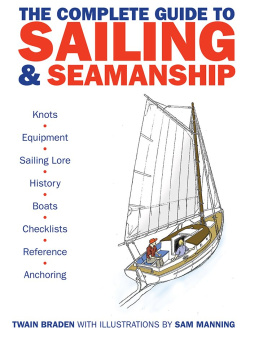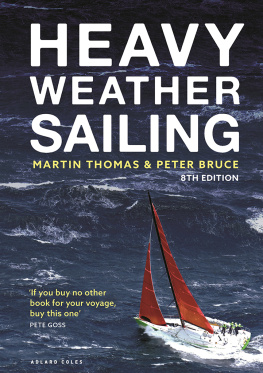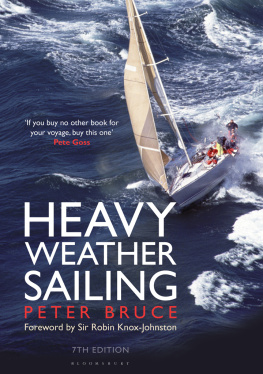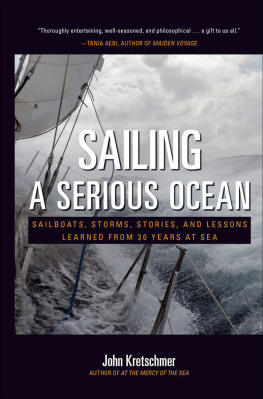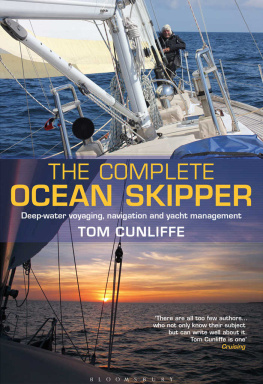I would like to say a special thank you to all the contributors of Heavy Weather Powerboating. Each one of them has given of their time and expertise most generously and indeed it has been a privilege to work with so many distinguished names. Many of them have been inspirational to me personally over the years. In the case of the photographs too; more than a few have been kindly supplied by a variety of friends and allies, all of whom can be credited with making this book unique in content and presentation.
Lastly, I would like to take this opportunity to dedicate Heavy Weather Powerboating to my great friend and offshore boating companion, Paul Lemmer, a man whose resourcefulness, determination and extraordinary sense of humour have always proved uplifting and invigorating, especially when the miles remaining have been many and the going has been hard.
HEAVY
POWERBOATING
WEATHER
HUGO MONTGOMERY-SWAN

First published [YEAR OF PUBLICATION] by
A & C Black
Bloomsbury Publishing Plc
50 Bedford Square, London, WC1B 3DP
www.acblack.com
This electronic edition published in 2012 by Bloomsbury Publishing Plc
Copyright Hugo Montgomery-Swan 2010
First edition published 2010
ISBN: 978 1 4081 5618 6
All rights reserved You may not copy, distribute, transmit, reproduce or otherwise make available this publication (or any part of it) in any form, or by any means (including without limitation electronic, digital, optical, mechanical, photocopying, printing, recording or otherwise), without the prior written permission of the publisher. Any person who does any unauthorised act in relation to this publication may be liable to criminal prosecution and civil claims for damages
The right of the author to be identified as the author of this work has been asserted by him in accordance with the Copyright, Designs and Patents Act, 1988.
A CIP catalogue record for this book is available from the British Library.
Note: while all reasonable care has been taken in the publication of this book, the publisher takes no responsibility for the use of the methods or products described in the book.
Visit www.acblack.com to find out more about our authors and their books. You will find extracts, author interviews, author events and you can sign up for newsletters to be the first to hear about our latest releases and special offers.
Contents
Of all of the mighty forces in motion upon this blue, jewel-like planet, the sea is perhaps the most awe inspiring, captivating and vital to life. Mans fascination with the sea is as old as his own existence. Since the dawn of time, humans have sustained themselves by means of it, explored its oceans and channels and even sought to master the great watery deep.
Who could not admit to delighting at the sight of a sparkling, sun drenched bay with the happy cries of children playing in its shallow turquoise waters? Likewise, who could deny the allure of the very same water from the vantage point of a cliff top, at the height of a raging gale? The roar of the wind, the stinging rain and the thundering might of the seas crashing upon the dark rocks; the sea in all its moods is something we are drawn to instinctively.
Our love affair with the sea goes hand in hand with our natural fear of it. In my view, anyone who claims not to fear its power and unpredictable nature cannot genuinely claim to know it. Indeed, those who fail to respect the sea put themselves in danger of having their lives claimed by it. Nevertheless, our irresistible desire to pit our abilities against the forces at work on our planet and revel in the business of challenging their ultimate supremacy is just one aspect of what being alive is all about.
Boats in all their forms reflect these fundamental truths and even human nature itself. Boats designed for pleasure, boats designed for the purpose of sustaining and enriching life, boats built to satisfy mans quest to explore the unknown, boats built to conquer other men: whatever the purpose, a vessels makeup reveals what lies within the heart of those who fashioned it. Through the centuries, as sail was replaced by the tell-tail smokestack and twisting propeller shaft, this transformation was a direct result of mans desire to go faster, develop more efficient means of travel and continue to trade unabated no matter what the prevailing conditions.
For many, the business of taking on the sea is a matter of necessity. Being a professional offshore mariner means there are occasions where there simply is no choice. For such men, the seas they ply far from land may well have to be challenged, even fought with if the survival of the vessel and its crew are to be gained. For those who choose to risk their own lives for the sake of others, their decision to put to sea in the face of grave danger is likely to have been made long before they don their all-weather gear and step up onto the heaving deck of a lifeboat. For others, like myself, there is a choice and the decision might be dictated by such needs as a pressing itinerary, a desire to push the envelope or even the little white puff from a starting pistol held aloft from the deck of a club tender.
This book is not written with a view to glamorising gung-ho powerboating activities, and neither does it promote risk taking. On the contrary, its aim is to highlight the true strength of the sea, to engender respect for it and to share an unrivalled collection of real life accounts and first hand experiences, as well as theoretical fact and practical know-how. All this against a backdrop of different skill sets, hull designs and sea types.
When lying in bed at night listening to the wild wind shaking the window frames, ones mind might try to imagine the black reality of the storm raging at sea and those who may be battling against it even fighting for their lives. Whatever the films may show, a full gale or storm at sea rarely generates orderly waves marching in impressive formation across a predictable seascape. On the contrary, truly adverse seastates equal chaos, little or no visibility, deafening noise, disorientation, fatigue and sickness, raw fear and the need for massive effort on the part of a crew to perform even the simplest function. As in the case of other disciplines involving the elements and our environment, good seamanship and the ability to survive will likely be down to good preparation, advance knowledge, an intimate understanding of our vessel and its equipment plus, most importantly, a steel-like determination not to give up.
If this book could be said to possess just one lesson that could be drawn from its pages, I feel it would be this. Dont go looking for trouble unnecessarily. By all means learn how to develop your abilities, raise your threshold and gain a true knowledge of the seas unique characteristics and of course your boat in relation to these, but in doing so, dont ever take her for granted. The sea may be beautiful but she is also a deadly mistress.
No doubt you have heard of the excelling value of Plan B? This involves always seeking to have an alternative up your sleeve if the unexpected strikes. This is no less crucial for those venturing to sea whether the motivation is for work or pleasure. Be it a second port of call, the lee of an island, a changing/favourable tide, an EPIRB or a friend at home next to the phone who knows your passage plan, always take care to have that Plan B in reserve. Never let haste or the excitements of putting to sea rob you of the opportunity to think through what you might do if things go wrong. The latter is dependant upon your experience as well as your ability to estimate genuine risk. But only the fool puts to sea ill-prepared or with a spirit of it wont happen to me overriding his thoughts and actions. Having a realistic approach to powerboating involves not only recognising a duty of care to yourself, but also to the lives and welfare of those in our care; our crew, our family and those who might need to come to the rescue if things go awry.
Next page


